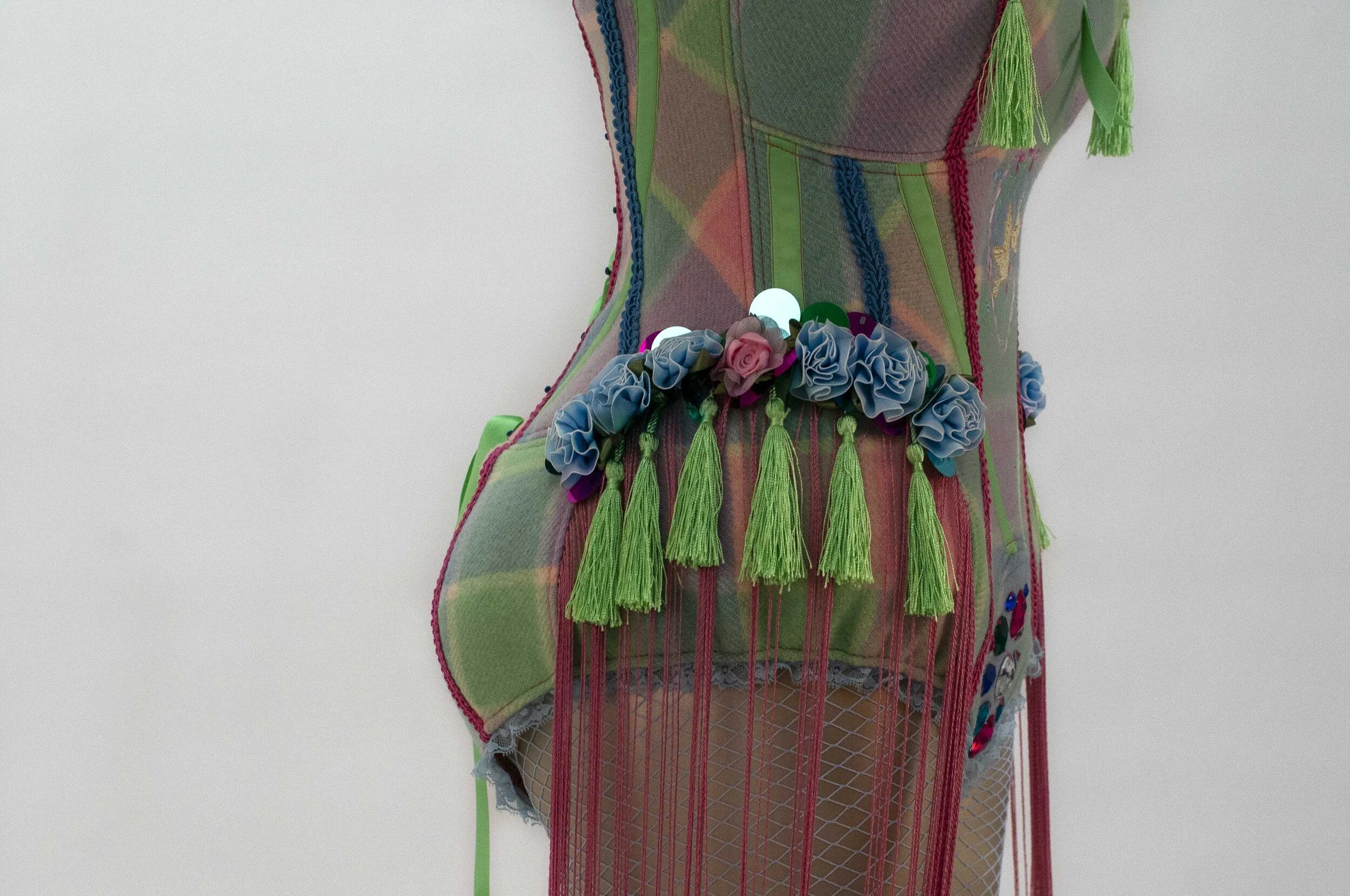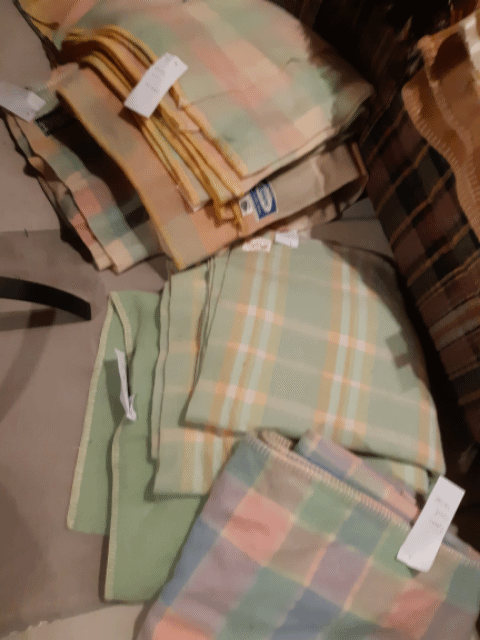Betty
Donna Dinsdale
Betty
Donna Dinsdale
New Zealand / Toi Ohomai Institute of Technology
The work presented is approached from a “playful” perspective, exploring the relationship between emerging sexualities and the stereotypical suburban housewife model of domesticity in the 1950s.
The term “sex bomb “was first used in the mid-1950s in relation to the popularity of certain film stars, including Marilyn Monroe, Brigitte Bardot and Raquel Welch. Historian, Elaine Tyler May argues that the domestic ideal of this post-war period was tied to past doubts, fears, and instability of the war, where during this time, cultural shifts of wartime encouraged challenges to gender norms and ideology.
Maria Elena Buszek’s study of the pin-up girl as a feminist icon argues that the classic pin-ups of World War II represented a “subversive model of female sexuality” that combined “conventional beauty, blatant sexuality, professional independence, and wholesome patriotism.”
Even though, throughout the 1950s there was still a conservative definition of gender roles, others embraced a shift in sexual mores traditionally embedded within the domestic role of the housewife with newfound sexual liberalism. Post-World War II there was a significant change in social expectations for what constituted a woman’s proper role outside the home. In a more contemporary context, research indicates that the media often depicts a narrow and often unattainable standard of women’s physical beauty and links this standard with a woman’s sexiness and worth within the domestic domain (Szymanski, Moffitt, Carr, 2011).
Betty as a domestic pinup could be seen as a forerunner to the model of feminine sexuality within the home. Who has resisted the traditional domestic model and who has constructed, unpacked and tried to understand her sexual identity and the unequal power relations between male and female.
In May of 1955, Housekeeping Monthly published an article entitled, “The Good Wife’s Guide,” detailing all the ways that a wife should act and how best she can be a partner to her husband and a mother to her children.
“Betty” epitomises this conflict, the tension between domestic harmony and the need to fulfill her husband’s, and her desires.
The narrative below positions the work as a social construct in a playful manner:
Honey I’m Home………
Suburbia 1955
Stanley arrives home after a long day at the office
Betty is in the kitchen preparing dinner
Him: Brrrrrrrrrr (entering the house)
Her: Hello love (shouting from the kitchen)
Him: Hello honey (entering the kitchen) It’s a cold, wet day out there (peck on cheek for Betty)
Her: It sure is, I couldn’t even hang the nappies out today!
Him: How’s your day been anyway honey?
Her: Same as usual but I did manage to get time for some sewing…...
Him: That’s nice. That’s great honey. Is the fire lit?
Her: Sorry love, I’ve been a bit busy, the triplets are in the bath and I’m just making your favourite meatloaf for dinner…….
Him: Well, I think I will relax and listen to the radio then (walking into the lounge)
Her: Yes, yes you do that
Him: Might need something to keep me warm though (chuckle)
Her: Ohhhhhhh (lustful look in Betty’s eyes)
Him: Have you seen that blanket, the one my mother gave us when we got married?
Her: No, no I haven’t, I may have lent it to my sister Maude (vacant look in Betty’s eyes)
Him: Well then, I guess a stiff whiskey will warm me up then
Her: Yes, yes you do that love, that will help…….
The captions for the images come directly from the May 1955 Housekeeping Monthly article.
References
Maria Elena Buszek, Pin-Up Grrrls: Feminism, Sexuality, Popular Culture. Durham. Duke University Press, (2006).
Elaine Tyler May, Homeward Bound: American Families in the Cold War Era. New York: Basic Books. (2008).
Dawn M. Szymanski,1 Lauren B. Moffitt,1 and Erika R. Carr. Sexual Objectification of Women: Advances to Theory and Research. (2011).
Photography: Anne Shirley; Fusemedia Design & photography; anneshirley@xtra.co.nz

“Greet him with a warm smile and show sincerity in your desire to please him”. Betty, Donna Dinsdale. Photos: Anne Shirley

“Speak in a low, soothing and pleasant voice”. Betty, Donna Dinsdale. Photos: Anne Shirley

“Be a little gay and a little more interesting for him”. Betty, Donna Dinsdale. Photos: Anne Shirley

“Put a ribbon in your hair and be fresh-looking”. Betty, Donna Dinsdale. Photos: Anne Shirley

“Clear away the clutter”. Betty, Donna Dinsdale. Photos: Anne Shirley

“Be happy to see your husband”. Betty, Donna Dinsdale. Photos: Anne Shirley

“Remember, he is the master of the house and as such will always exercise his will with fairness and truthfulness”. Betty, Donna Dinsdale. Photos: Anne Shirley

Betty process slide show. Donna Dinsdale.
Bio: Donna Dinsdale
email: Donna.Dinsdale@toiohomai.ac.nz
Masters of Art and Design Thesis http://aut.researchgateway.ac.nz/handle/10292/8913
Hokonui Fashion Design Awards https://www.stuff.co.nz/national/114529772/donna-dinsdales-menswear-entry-wins-hokonui-fashion-design-awards
Westfield Style Pasifika Fashion Awards https://designerdirection.wordpress.com/2009/08/26/bay-fashion-students-dominate-at-westfield-style-pasifika-awards/
Donna Dinsdale is an educator and practitioner specialising in Fashion Design, and in particular textiles and free-form draping. Using sustainable practice as a foundation for much of her work, the aesthetic value of re-purposed textiles and trims often drives the work, allowing for the freedom to experiment, develop and create in an unrestricted but thoughtful manner.
“My practice is positioned within the framework of a reflective bi-cultural perspective within personal lived experience as a method of investigating, experimenting and developing textiles into cultural artefacts. I believe the richness within the multicultural landscape we call Aotearoa allows me to demonstrate various design approaches and symbolic references through my work.”
As a practitioner, textiles have always been connected to her domestic background, as well as her professional career in the fashion industry. The starting point in her design approach is almost always the textiles themselves, which she uses to drape, sculpt and create three dimensional pieces on the mannequin.
“I find there is an absence of restrictions in this free form draping method which enables me to push boundaries of traditional garment structure, and to achieve more innovative, conceptual outcomes.”
Currently a tutor on The Bachelor of Creative Industries at Toi Ohomai Institute of Technology in Tauranga, she believes within the framework of education, her on-going research practice will increase her contribution as a creative / fashion design tutor for numerous reasons. There are many levels of inquiry within the theoretical and practical elements of her practice that can be implemented to support student learning.
“I have experienced within my teaching that students require individual nurturing and encouragement to be able to create their own fashion language through drawing upon personal cultural backgrounds and life experiences. Many of my research projects and supporting experimentation can be applied as a visual and theoretical teaching tool, highlighting cross-cultural pollination within lived experience. Just as research has empowered me with a more in-depth diverse contextual understanding, I can share this approach with my students, encouraging them to work on a personal cultural level, to uncover the possibilities that this offers in a contemporary fashion design context.”
